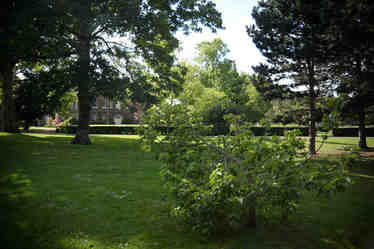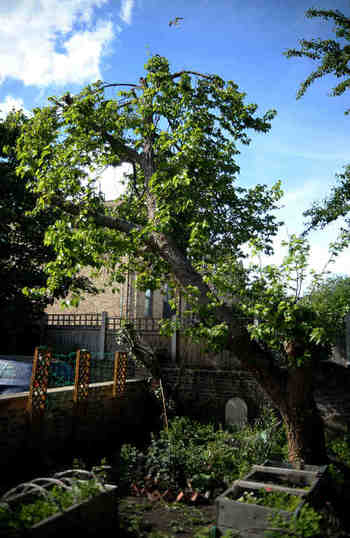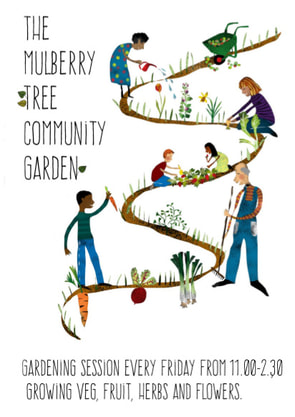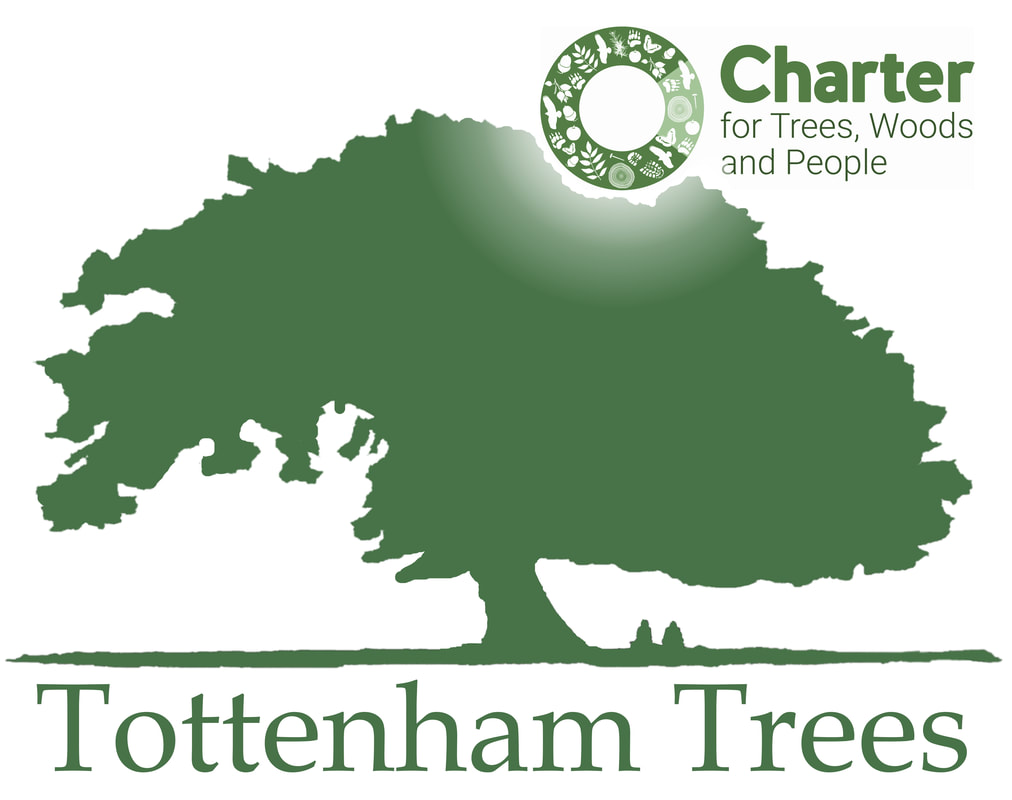|
Mulberry Tree
The Mulberry Tree in the Quaker Meeting House garden is closely associated with Tottenham cake: a square sponge covered in pink icing - the pink colour being provided by the mulberries. From the Tottenham Quakers: Ted Willis (later Lord Willis) recalls in his autobiography “a peculiar local invention was Tottenham Cake. It consisted of a scone like base covered with lurid pink icing. It was baked in long flat trays, then cut into cubes, which retailed for a penny each. Luckily the cake was not always cut evenly or the icing uniformly spread, and the smaller defective pieces were sold off at half price. “In 1901 it was given away free to local children to celebrate the Spurs first victory in the FA Cup Final” [...] Henry Chalkley, the baker, was a Friend. The tradition of a Tottenham cake is continued today at Tottenham Friends Meeting. Now baked by Peter Brown, the pink icing is usually achieved by using mulberries off the tree in the burial ground. |
Tottenham was a rural village when the Quakers first moved to the area and the practical nature of the cake allowing for pieces to be cut easily and shared, reflects Quaker engagement with the community. Tottenham cake is still available in local bakeries though the icing is from sources other than the mulberry. The remaining mulberry tree, which had been overgrown in recent years, has now been trimmed as part of the renovation of the garden.
Christine Protz, Local Historian:
When we were children it did not seem remarkable that there should be a mulberry tree behind our houses in Reform Row. It was a magnificent tree, regularly producing a good crop of mulberries and one of the last remnants of the 17th century orchard behind the Quaker meeting house. Our tree found itself in the forecourt of the small factory behind Reform Row and pressed up against the newly built gymnasium of Parkhurst School. It was clearly a survivor
Our mothers would let us know when the mulberries were ripe for picking, and on a Sunday, when the factory was closed, we would climb over the wooden gates and into the factory grounds clutching our bowls for the fruit. We knew this was scrumping, but to our mind the tree did not belong to anyone and its splendid fruit would otherwise go to waste. We scrambled up the lower branches, the bigger children helping the little ones, and with luck gain access to the flat gym roof, where we could wander round collecting the rich purple fruit. Plenty went into our bowls, but quite a lot into our mouths. On one occasion I remember being told off by my friend because I ate too many mulberries and there was not enough for my mum to make jam. My mum’s jam was highly regarded in our family and the street
The tree did not long survive the new ownership of the factory in the 1970s, but a companion tree lasted a lot longer in the playground of the nearby Parkhurst School – since renamed the Mulberry School in honour of that survivor.
When we were children it did not seem remarkable that there should be a mulberry tree behind our houses in Reform Row. It was a magnificent tree, regularly producing a good crop of mulberries and one of the last remnants of the 17th century orchard behind the Quaker meeting house. Our tree found itself in the forecourt of the small factory behind Reform Row and pressed up against the newly built gymnasium of Parkhurst School. It was clearly a survivor
Our mothers would let us know when the mulberries were ripe for picking, and on a Sunday, when the factory was closed, we would climb over the wooden gates and into the factory grounds clutching our bowls for the fruit. We knew this was scrumping, but to our mind the tree did not belong to anyone and its splendid fruit would otherwise go to waste. We scrambled up the lower branches, the bigger children helping the little ones, and with luck gain access to the flat gym roof, where we could wander round collecting the rich purple fruit. Plenty went into our bowls, but quite a lot into our mouths. On one occasion I remember being told off by my friend because I ate too many mulberries and there was not enough for my mum to make jam. My mum’s jam was highly regarded in our family and the street
The tree did not long survive the new ownership of the factory in the 1970s, but a companion tree lasted a lot longer in the playground of the nearby Parkhurst School – since renamed the Mulberry School in honour of that survivor.
|
Join in the weekly gardening sessions at the Mulberry Tree Community Garden Fridays from 11am onwards. The Mulberry Tree Community Garden is a place for growing fruit, veg, herbs, flowers, skills, ideas and community. It is open for everyone and we especially welcome asylum seekers, refugees and other migrants to join in, get to know the neighbourhood and find a sense of belonging. You will be able to take veg, herbs and fruit home with you and we share recipes and ideas for cooking. No experience necessary. Lunch, tea, coffee, tools and gloves provided, plus transport costs for asylum seekers and others on low incomes. Kids welcome (if supervised by an adult). There is an indoor space and toilets, but unfortunately these do not have disabled access. Mulberry Tree Community Garden, 594 Tottenham High Road, London, N17 9TA. Near Bruce Grove station. Buses 149, 243, 259, 341, 476 |
 A recent addition to Bruce Castle Park. Photo by Noel Treacy.
A recent addition to Bruce Castle Park. Photo by Noel Treacy.
A Mulberry tree in Bruce Castle Park featured in A Description and History of Vegetable Substances used in the Arts and in Domestic Economy published by Charles Knight in 1829:
It is recorded that, at Bruce Castle, at Tottenham, an immense branch was torn off by the wind from an old mulberry tree about 40 years ago. The branch was thrust into the ground, and flourished. It is now a handsome tree. That part of the trunk of the old tree which lost the branch is covered with lead.
It is recorded that, at Bruce Castle, at Tottenham, an immense branch was torn off by the wind from an old mulberry tree about 40 years ago. The branch was thrust into the ground, and flourished. It is now a handsome tree. That part of the trunk of the old tree which lost the branch is covered with lead.



